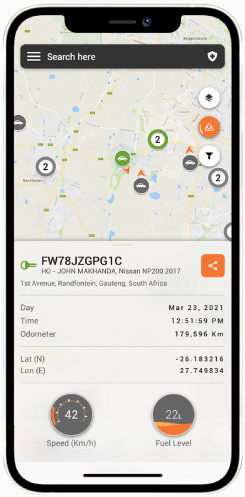
DRIVER BEHAVIOUR MONITORING FOR FLEET MANAGEMENT AND GPS VEHICLE TRACKING
Driver Behaviour
What is Driver Behaviour
Curbing Poor Driver Behaviour in Fleet Management
Driver behavior refers to the actions and habits of a driver while operating a vehicle. It encompasses various aspects such as acceleration, braking, steering, speed and adherence to traffic laws and regulations. Driver behavior can have a significant impact on road safety, fuel consumption, vehicle wear and tear, and overall fleet efficiency.
Therefore, monitoring and analyzing driver behaviour is crucial for improving safe driving practices and minimizing risks on the road.
Cartrack NZ provides valuable insights into driver behaviour by monitoring various aspects of the vehicle’s performance and location in real-time.

Driver behaviour is a key part of operational and reputational management for any business.
It is particularly critical in fleet management, as implementing more efficient and accountable driving practices could not only increase the bottom line of companies, but inculcate far better safety for all concerned.
One of the most effective means to curb poor driver behaviour is intelligent telematics in fleet management. Fleet managers can extract data relating to both their drivers and their fleet of vehicles, and based on this data, take appropriate action.
This data can be collected in real-time, which means that there can be swift and timely remedies taken to curb costly driver behaviour.
Good driver practices are important because:
- Poor driver behaviour is the main factor in road accidents
- Poor driver behaviour shortens the life of your vehicle
- Driver behaviour impacts fuel consumption
- Better driver behaviour will increase productivity and efficiency
With Cartrack’s real-time, event-based tracking, you can set up location, geofence, speeding and driving behaviour notifications to be sent straight to your mobile phone
- Speeding Notifications: A vehicle travelling at 107kms per hour uses 20-25% more fuel than a vehicle travelling at 100kms per hours.
- Alerts: Use Alerts to highlight any event where a vehicle travels over the road speed limit. Customise it further to specify speeding events over a certain kms per hour, to target the occurrences in which you are notified about.
- Harsh Driving Notifications: A vehicle which is subjected to harsh breaking, acceleration or cornering can require more frequent servicing and maintenance, costing the company more per vehicle in the long run.
- Unscheduled Usage Alerts: Maintain worksite safety and ensure heavy machinery isn’t used out of hours.
- Failure to Arrive on Time Alerts: Keep your customers and clients happy by immediately alerting them to any delays in service.
- Worktime: particularly useful for Drivers on the road for long periods of time. Set an Alert after a certain number of hours for the Driver to stop and take a break.

How to improve driver behaviour
Driver behaviour reports
Get driver scorecard data reports from a fleet platform and get the driver insights you need to pick up idling, aggressive driving, speeding, and more – all of which are costly to a fleet.
Get detailed reports for each behaviour. Say for instance, speeding is an ongoing trend with one of your drivers, then pull up a detailed speeding analysis. It could have detailed locations, duration and distance travelled over maximum speed limits, so you can get the full picture of a speeding incident. Or maybe your fuel costs spiked, get an excessive idling report to see if this is the cause.
On-demand trip reports can also be retrieved if you want to analyse and compare all your vehicles, and the drivers using those vehicles.
Driver behaviour alerts and reminders
With all the daily tasks a fleet manager faces, a fleet platform will help with its alerts and reminder features. Managers can customise driver behaviour alerts and receive the info they feel is necessary. So they can create a trigger alert for when the ignition is on and off, and choose where they want the alert to go, i.e. email. Or get alerts in real-time when safety rules aren’t followed, and correct this immediately.
Drivers can get preventative in-cabin alerts in real-time too, so they know when they are breaking the rules of the road or safety violations. For instance, if they are not leaving a proper distance from the other vehicle. Also create reminders for certain events, so for example, maybe you want to be reminded to check a certain route a driver is taking, to see if speeding persists.
AI-powered cameras
Get up to eight internal or external cameras to help keep your drivers, fleet, and cargo safe. These cameras can pick up all sorts of detection including front collision warnings, smoke detection, distracted driving, yawning, and more. Smart In-cabin screens keep your drivers safe and they can get visibility of their blind spots, and the cameras alert them in real-time of any dangers or issues. With the footage, you’ll also be able to protect drivers from false accident claims. In the event of poor driving, fleet managers can also use the footage to bring up the incident with the driver in question.
